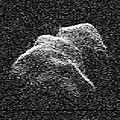Goldstone Solar System Radar facts for kids
The Goldstone Solar System Radar (GSSR) is a giant radar system. It helps scientists study objects far away in our Solar System. You can find it in the desert near Barstow, California.
GSSR uses a powerful transmitter to send out radio waves. It also has a special receiver on a huge 70-meter antenna. This antenna is part of the Goldstone Deep Space Communications Complex.
Scientists use GSSR to explore planets like Mercury, Venus, and Mars. It also helps them learn about asteroids and the moons of Jupiter and Saturn. Before GSSR, the Arecibo Observatory had a similar radar. But now, GSSR is the only one of its kind.

Goldstone Deep Space Network
|
|
| Alternative names | Goldstone radar |
|---|---|
| Part of | DSS 14 |
| Location(s) | California |
| Coordinates | 35°25′36″N 116°53′24″W / 35.4267°N 116.89°W |
| Organization | California Institute of Technology Jet Propulsion Laboratory NASA |
| Altitude | 2,950 ft (900 m) |
| Telescope style | radar radio telescope space instrument |
| Diameter | 70 m (229 ft 8 in) |
| Website | gssr |
Contents
How GSSR Explores Space
GSSR can work in two main ways to study objects in space. These are called monostatic and bistatic modes.
Monostatic Mode: Send and Receive
In the monostatic radar mode, GSSR does both jobs. It sends out radio waves and then listens for the waves that bounce back. This is like shouting in a cave and hearing your own echo.
Bistatic Mode: Teamwork in Space
In bistatic mode, GSSR sends out the radio waves. But other radio telescopes around the world listen for the returning signals. This is like one person shouting and many people listening for the echo.
This teamwork has cool benefits:
- GSSR doesn't have to stop sending waves to listen. This means more continuous data.
- It allows for interferometry. This is a special technique that combines signals from different telescopes. It helps scientists get even more detailed information from the reflected waves.
Planets and Asteroids Studied by GSSR
GSSR has helped us learn a lot about many different objects in our solar system.
Mercury: Uncovering its Secrets
GSSR has closely watched Mercury. By tracking how reflected signals move across Earth, scientists can figure out Mercury's exact tilt. Measurements show that Mercury has a liquid core, like Earth's.
Mars: Preparing for Landings
GSSR was very important for studying Mars. It helped scientists pick the best and safest spots for spacecraft to land on the Red Planet.
Asteroids: Seeing What Telescopes Can't
Small asteroids often look like tiny dots of light through regular telescopes. But radar, like GSSR, can create detailed images of them. It can see features just a few meters big.
For example, the asteroid 4179 Toutatis has been imaged many times by GSSR. This happened in 1992, 1996, 2000, 2004, 2008, and 2012. While spacecraft like Dawn can get super close-up pictures of specific asteroids, radar astronomy can study many more. It helps us understand different types of asteroids. In fact, all known images of asteroids that have two parts (binary asteroids) were made using radar astronomy.
Moons and Rings of Jupiter and Saturn
GSSR has also been used to study the many moons of Jupiter. It has also explored the rings and moons that orbit Saturn.
Other Uses of GSSR
GSSR isn't just for studying planets and asteroids. It has other important jobs too.
Helping Spacecraft in Trouble
GSSR helped find and fix the Solar and Heliospheric Observatory spacecraft. This spacecraft had lost its way in space. GSSR helped guide it back to normal.
Tracking Space Junk
GSSR also helps scientists keep an eye on space debris. This is like trash orbiting around Earth. Knowing where it is helps keep satellites and spacecraft safe.
Images for kids





